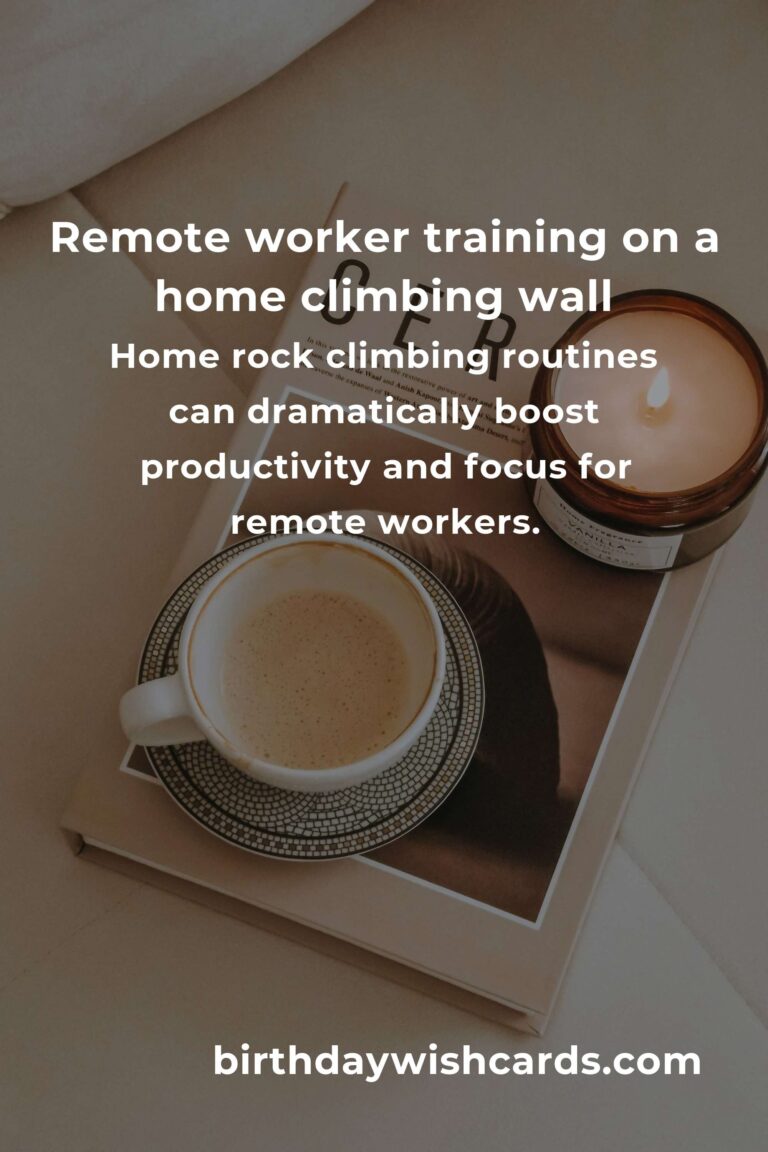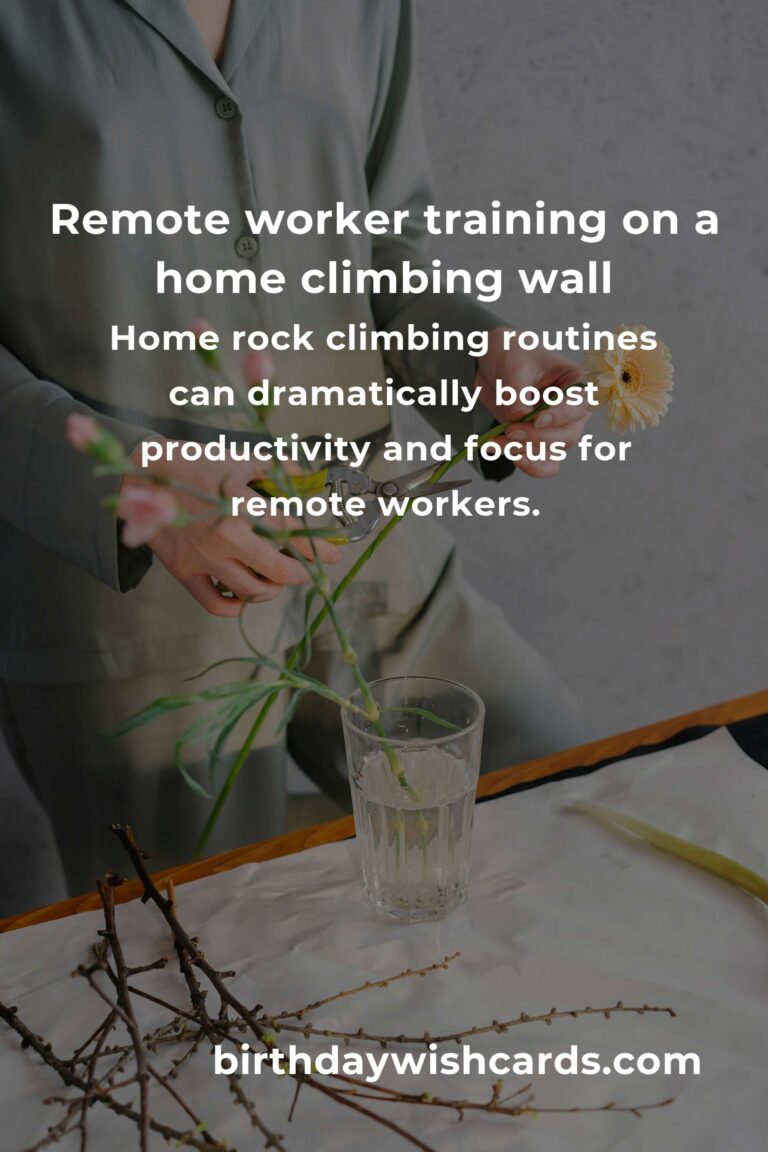
As remote work becomes the new normal, many of us are searching for ways to break free from our sedentary routines and infuse energy into our work-from-home lifestyles. If you’re a desk-bound professional longing for an engaging, full-body workout that also sharpens your mental focus, a home rock climbing routine could be your secret weapon. This article explores how you can transform your home into a climbing-friendly space, build a sustainable routine, and enhance both your productivity and well-being.
Why Rock Climbing Is the Ultimate Home Fitness Solution for Remote Workers
Rock climbing isn’t just a thrilling adventure sport—it’s also an incredible way to combat the physical and mental stagnation that often comes with remote work. Here’s why:
- n
- Full-body engagement: Climbing calls upon nearly every muscle group, from your fingertips to your toes.
- Boosts brainpower: Navigating climbing routes sharpens problem-solving and focus—skills directly transferable to your work tasks.
- Stress relief: The physical exertion and mindful movement of climbing help mitigate the stress and anxiety of work-from-home life.
- Flexible and scalable: You can design routines for all levels, from beginner to advanced, and adjust as you improve.
n
n
n
Setting Up Your Home for Rock Climbing: What You Need
Turning your living space into a mini climbing gym might sound daunting, but with a little creativity and investment, it’s entirely possible—even in small apartments. Here’s what to consider:
1. Home Climbing Walls
Home climbing walls (also called woody boards or training boards) are the ultimate solution. You can build a simple vertical wall, a slightly overhanging wall, or even a hangboard setup above a doorway. Modular panels, pre-made systems (like MoonBoard or Tension Board), or DIY builds are all options, depending on your space and budget.
2. Hangboards & Fingerboards
Even if space is tight, a hangboard can be mounted above a doorframe. These boards feature various grips for finger-strength training—crucial for climbers of all ability levels.
3. Climbing Holds and Hardware
Invest in a set of climbing holds (jugs, crimps, slopers, pockets, pinches). These can be rearranged to create new routes and challenges as your skills progress. Don’t forget mounting hardware and safety mats beneath your setup.
4. Safety First
Always ensure your wall and holds are securely installed, and use crash pads or gym mats to cushion any falls. If you’re unsure, consult a professional or use reputable kits designed for home use.
Designing a Home Rock Climbing Routine
The beauty of a home climbing routine is its flexibility. Here’s how to structure a balanced, productive regimen to fit into your remote workday:
Morning Energizer (10–15 Minutes)
- n
- Warm-up: 5 minutes of dynamic stretching (arm circles, jumping jacks, wrist rotations).
- Easy Laps: Do 2–3 laps on your easiest route or traverse. Focus on smooth movement and controlled breathing.
n
Midday Reset (20–30 Minutes)
- n
- Skill Practice: Pick one climbing skill to focus on—like footwork precision, silent feet, or flagging. Do 3–4 attempts, resting between tries.
- Strength Circuit: Combine 2 sets of pull-ups (or assisted pull-ups), 2 sets of push-ups, and 2 sets of core exercises (planks, mountain climbers).
- Hangboard Session (Optional): For intermediate/advanced climbers, 2–3 sets of hangs on various grip types.
n
n
Afternoon Power-Up (10 Minutes)
- n
- Movement Drills: Try traversing left-to-right and right-to-left across your wall for 5 minutes.
- Balance Challenge: Attempt one-foot stands or slow, controlled movements to focus on balance and core stability.
n
Evening Cooldown (10 Minutes)
- n
- Stretching: Focus on forearms, shoulders, hips, and back.
- Mindfulness: End with 5 minutes of breathing exercises or meditation to transition from work to rest.
n
Sample Weekly Home Climbing Schedule
| Day | Morning | Midday | Afternoon | Evening |
|---|---|---|---|---|
| Monday | Warm-up + Easy Laps | Skill Practice (Footwork) | Traverse Drill | Stretch & Breathe |
| Tuesday | Warm-up + Easy Laps | Strength Circuit | Balance Challenge | Stretch & Breathe |
| Wednesday | Warm-up + Easy Laps | Hangboard Session | Traverse Drill | Stretch & Breathe |
| Thursday | Warm-up + Easy Laps | Skill Practice (Dynamic Moves) | Balance Challenge | Stretch & Breathe |
| Friday | Warm-up + Easy Laps | Strength Circuit | Traverse Drill | Stretch & Breathe |
Adjust the intensity and frequency as needed. For weekends, try a fun “challenge climb” or rest and recover with active stretching.
Climbing Drills to Enhance Productivity and Focus
Integrating climbing into your day is about more than just fitness—it’s a way to reset your mind. Here are some drills to keep your brain sharp:
- n
- Route Reading: Before touching the wall, visualize your moves. This mental rehearsal boosts both climbing skill and cognitive focus.
- Silent Climbing: Move as quietly as possible. This heightens body awareness and concentration—perfect for clearing your mind between meetings.
- Timed Sprints: Set a timer and climb a route as many times as possible in 2 minutes. This quick burst can wake you up from midday sluggishness.
n
n
Staying Motivated: Making Home Climbing Social & Fun
Staying consistent with a home climbing routine can be tough without the camaraderie of a gym. Here’s how to keep it engaging:
- n
- Virtual Challenges: Connect with friends or colleagues and share your progress via video calls or apps.
- Route Setting: Regularly rearrange holds to keep your routine fresh and stimulating.
- Family Involvement: If you have kids, create easy routes for them and climb together for family fitness.
n
n
Common Challenges & How to Overcome Them
Space Limitations
If you’re short on space, focus on finger training and bodyweight exercises. Even a hangboard and resistance bands can provide tremendous benefits.
Motivation Slumps
Set clear, achievable goals—like mastering a new grip or climbing for a certain number of minutes each day. Track your progress in a journal or app.
Physical Fatigue
Listen to your body. Prioritize rest days and active recovery to avoid overuse injuries. Hydrate and fuel your body with balanced nutrition.
Complementary Exercises for a Balanced Routine
To round out your climbing training and promote overall health, incorporate these exercises:
- n
- Mobility: Yoga or dynamic stretching for hip, shoulder, and back flexibility.
- Cardio: Brisk walking, running, or cycling 2–3 times a week to support heart health.
- Strength: Bodyweight squats, lunges, or resistance band workouts to target lower body and core stability.
n
n
Mental Benefits: Why Remote Workers Thrive with Climbing
Beyond the physical perks, climbing offers profound emotional and cognitive rewards:
- n
- Stress Reduction: The focus required during climbing is a natural antidote to workday worries.
- Confidence: Overcoming new routes and challenges builds resilience and self-belief—qualities that spill over into your professional life.
- Mindfulness: Climbing demands presence. It’s a moving meditation that grounds you in the moment, easing anxiety and improving mood.
n
n
Essential Gear Recommendations for Home Climbers
Here’s a quick checklist for your home climbing setup:
- n
- Climbing shoes (comfortable, not too tight for home use)
- Chalk and chalk bag
- Hangboard/fingerboard
- Crash pad or thick yoga mat
- Variety of holds (mix of jugs, crimps, slopers, pockets)
- Resistance bands for warm-up and conditioning
- Foam roller for muscle recovery
n
n
n
n
n
n
Creating a Dedicated Climbing Space: Tips for Remote Workers
Even a small corner can become your climbing sanctuary. Here’s how:
- n
- Choose a low-traffic area, ideally with a solid wall or doorframe.
- Keep your gear organized and accessible. A basket or wall-mounted rack can help.
- Decorate with motivational posters or photos of your favorite climbing destinations for inspiration.
n
n
Inspiring Stories: Remote Workers Who Changed Their Lives with Home Climbing
Consider Sarah, a freelance writer who struggled with back pain and creative blocks. After installing a simple hangboard in her apartment, she began short climbing sessions between writing sprints. Within weeks, her posture improved and her ideas flowed more freely. Or Mike, a tech professional who built a small climbing wall in his basement to break up long coding sessions. He found not only renewed energy but also a sense of accomplishment that boosted his work performance.
These stories aren’t unique—any remote worker can harness the power of home climbing. All it takes is a willingness to start small, stay curious, and celebrate each milestone along the way.
Conclusion: Climb Higher, Work Better, Live Well
Integrating a home rock climbing routine into your remote work life isn’t just about fitness—it’s about reclaiming energy, focus, and joy in your day. Whether you have a full climbing wall or just a hangboard, every step taken off the ground is a step toward better health, sharper thinking, and a more balanced life.
Start your journey today. Your mind, body, and career will thank you.
Home rock climbing routines can dramatically boost productivity and focus for remote workers.
Climbing breaks up sedentary workdays with energizing, full-body movement.
You don’t need a huge space—hangboards or small training walls can fit in most homes.
Climbing exercises engage both body and mind, sharpening problem-solving and reducing stress.
Short, consistent sessions throughout the day help maintain motivation and avoid burnout.
Setting small goals and tracking progress makes climbing at home fun and rewarding.
Climbing with family or virtually with friends can add social connection to your fitness.
Balanced routines with stretching and strength work prevent injury and improve well-being.
Many remote workers report better mood, posture, and work performance after starting a climbing routine.
Anyone can get started with minimal gear, and the benefits extend far beyond just physical health.
#RemoteWorkFitness #HomeClimbing #ProductivityHacks #ClimbingRoutine #WorkFromHomeWellness #DeskDetox #ClimbStrong #MentalHealthMatters #FitAtHome #MoveMore

